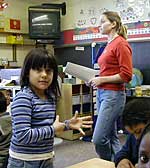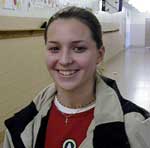A Pattern of Success
By Tim Pugmire , Minnesota Public Radio
March 6, 2001
Educators throughout Minnesota have criticized Gov. Ventura's proposed budget as insufficient for public schools, but supporters of the state's Indian education programs are not complaining.
Ventura wants to double the current funding targeted to American Indian students in an attempt to lower one of the state's highest dropout rates.
STATE EDUCATION OFFICIALS SAY more than 34 percent of American Indian students in Minnesota fail to get a high school diploma on time, compared to eight percent for white students. Over the past 10 years, however, school districts receiving state funding for American Indian education have been able to cut dropout rates by about half, and they've doubled the number of students going to college. The money is distributed through competitive grants every two years. There are 24 school districts currently getting the state funds.
Yvonne Novack, Indian Education manager for the Department of Children, Families and Learning, says Minnesota has acknowledged American Indian students face unique academic challenges.
"We're the only state in the nation with an Indian education act. We have the largest appropriation from state government for Indian education. The state has really become partners with the federal government and tribes in providing educational opportunities for Indian students," Novack says.
Gov. Ventura's budget plan rolls three existing Indian Education programs into a new program called Success for the Future. As part of a proposed increase in overall K-12 spending of $489 million, Ventura provides Indian Education $6.7 million, twice as much as its current state allocation.
Ventura's education commissioner, Christine Jax, says the governor is willing to put money in programs with clear evidence of success.
"When the governor is looking for where he wants to put money he asks commissioners, 'Where can you show me it makes a difference?' When it comes to academic achievement, we found a very strong relationship between the program, the money we put into Indian Education, and the dropout rate for those students," Jax says.
Success for the Future would combine programs aimed at reducing dropout rates, raising student test scores and encouraging students to go to a two- or four-year college after high school. School districts would continue to compete for grants and use the money to develop programs ranging from drum groups to native language instruction.
Yvonne Novack says one of the keys to keeping American Indian students in school is a curriculum that acknowledges their culture and heritage.
"If students see who they are in the curriculum on a regular basis, and it becomes just part of the regular everyday life of the school, they constantly see themselves then as part of the school, as part of that environment," says Novack. "Other children then see them as part of that environment, and not something that's set a side to acknowledge on a special day."
UNDERSTANDING TRADITIONS In a classroom at Crestview Elementary School in Brooklyn Park, Danielle Bosquez helps kindergarten students draw pictures about the story she reads to them. Bosquez, a junior at Osseo High School, is among several students and parents who participate in the district's American Indian storytelling project.
Bosquez says she's beginning to understand the importance of storytelling traditions and her own Indian heritage.
"When I was younger, I didn't know anything about my Indian heritage," Bosquez says. "I've learned that me not knowing about mine makes me more willing to learn about other peoples' heritage and be able to accept them. And I think that helped me a lot."
In addition to storytelling, American Indian students in the Osseo district attend special after school classes on culture and language. Students also run an ongoing enterprise called Little Buffalo Crafts. Participants create and sell historically authentic crafts with the help of mentors from the American Indian community.
Priscilla Buffalohead, the district's Indian Education coordinator, says the state grants are critical to keeping local programs afloat.
"I have never seen a public school district pick up the funds for Indian education, even though many of these programs have proved to be very, very successful," she says. "I think that probably is one of the reasons for this is American Indians represent a very small minority population in the schools, and schools look at numbers."
In the Osseo school district, Indian Education is serving 195 students out of a total enrollment of 22,000. Eligible students must be enrolled tribal members, or have a parent or grandparent who is a member of a tribe. Statewide, Indian Education programs serve about 9,000.
State education officials say the additional funding, if approved by the Legislature, would help provide grants to most of the 64 Minnesota school districts with a federally recognized American Indian enrollment of at least 10 students.
By Tim Pugmire , Minnesota Public Radio
March 6, 2001
|
|
RealAudio |
Educators throughout Minnesota have criticized Gov. Ventura's proposed budget as insufficient for public schools, but supporters of the state's Indian education programs are not complaining.
Ventura wants to double the current funding targeted to American Indian students in an attempt to lower one of the state's highest dropout rates.
| |
|
|
|
||
Yvonne Novack, Indian Education manager for the Department of Children, Families and Learning, says Minnesota has acknowledged American Indian students face unique academic challenges.
"We're the only state in the nation with an Indian education act. We have the largest appropriation from state government for Indian education. The state has really become partners with the federal government and tribes in providing educational opportunities for Indian students," Novack says.
Gov. Ventura's budget plan rolls three existing Indian Education programs into a new program called Success for the Future. As part of a proposed increase in overall K-12 spending of $489 million, Ventura provides Indian Education $6.7 million, twice as much as its current state allocation.
Ventura's education commissioner, Christine Jax, says the governor is willing to put money in programs with clear evidence of success.
"When the governor is looking for where he wants to put money he asks commissioners, 'Where can you show me it makes a difference?' When it comes to academic achievement, we found a very strong relationship between the program, the money we put into Indian Education, and the dropout rate for those students," Jax says.
Success for the Future would combine programs aimed at reducing dropout rates, raising student test scores and encouraging students to go to a two- or four-year college after high school. School districts would continue to compete for grants and use the money to develop programs ranging from drum groups to native language instruction.
Yvonne Novack says one of the keys to keeping American Indian students in school is a curriculum that acknowledges their culture and heritage.
"If students see who they are in the curriculum on a regular basis, and it becomes just part of the regular everyday life of the school, they constantly see themselves then as part of the school, as part of that environment," says Novack. "Other children then see them as part of that environment, and not something that's set a side to acknowledge on a special day."
UNDERSTANDING TRADITIONS In a classroom at Crestview Elementary School in Brooklyn Park, Danielle Bosquez helps kindergarten students draw pictures about the story she reads to them. Bosquez, a junior at Osseo High School, is among several students and parents who participate in the district's American Indian storytelling project.
Bosquez says she's beginning to understand the importance of storytelling traditions and her own Indian heritage.
| |
|
|
|
||
In addition to storytelling, American Indian students in the Osseo district attend special after school classes on culture and language. Students also run an ongoing enterprise called Little Buffalo Crafts. Participants create and sell historically authentic crafts with the help of mentors from the American Indian community.
Priscilla Buffalohead, the district's Indian Education coordinator, says the state grants are critical to keeping local programs afloat.
"I have never seen a public school district pick up the funds for Indian education, even though many of these programs have proved to be very, very successful," she says. "I think that probably is one of the reasons for this is American Indians represent a very small minority population in the schools, and schools look at numbers."
In the Osseo school district, Indian Education is serving 195 students out of a total enrollment of 22,000. Eligible students must be enrolled tribal members, or have a parent or grandparent who is a member of a tribe. Statewide, Indian Education programs serve about 9,000.
State education officials say the additional funding, if approved by the Legislature, would help provide grants to most of the 64 Minnesota school districts with a federally recognized American Indian enrollment of at least 10 students.


